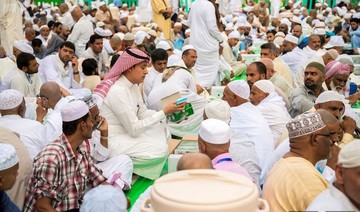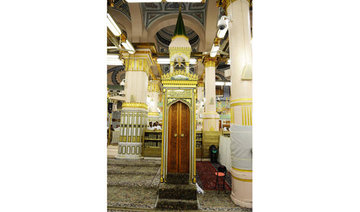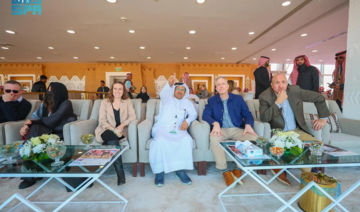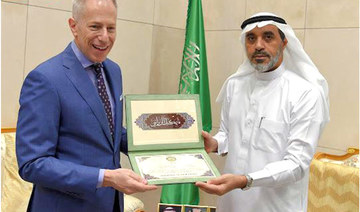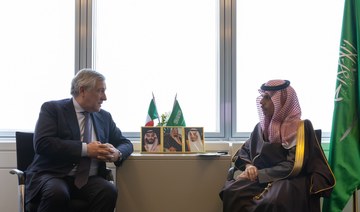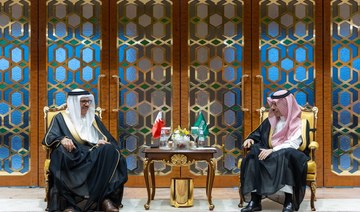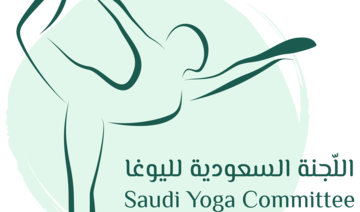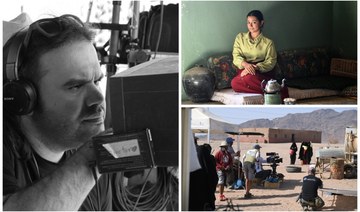The Prophet’s Mosque in Madinah is a place Muslims from around the world visit while performing Hajj and Umrah, or simply to pray (performing the salat) and visit Prophet Muhammad’s tomb.
One of the world’s largest mosques, the Prophet’s Mosque underwent several expansions throughout its history, starting with the days of the caliphs, followed by the Umayyads, the Abbasids, the Ottomans, and, finally, the Saudi era, during which it underwent the largest expansion in its history and was the first place in the Arabian Peninsula to be lit by electric light bulbs in 1909 (1327 AH).
The Prophet’s Mosque, also known as Al-Masjid Al-Nabawi, was the second mosque built by Prophet Muhammad (peace be upon him) in the first year of Hijrah (the Prophet’s migration with his followers from Makkah to Madinah, which was called Yathrib at the time).
The land on which the mosque was built belonged to two orphans, Sahl and Suhail, and was used as a place for drying dates. The Prophet planned the mosque’s structure to occupy a 50 by 49 meter tract of land and built it facing Jerusalem, the Muslim’s Qibla at the time. He dug the foundation and used palm leaves for the roof and trunks of palm trees as columns.
The Prophet also built his mosque with three doors, one of which was in the back and was called “Atikah” or the “Door of Mercy,” while the other was the “Door of Gabriel” and was the Prophet’s preferred entrance.
In the back of the mosque, there was a shady area for sheltering the poor and strangers known as “Al-Saffa.”
Prophet Muhammad did not build a roof for the entire mosque, so when it rained, water would drip on worshippers. The worshippers asked the Prophet to support the roof with mud, but he refused and said: “No, an arish like that of Moses” — a trellis roof like that of Moses.
In its early days, the mosque’s floor was not covered with anything until in 3 AH (624 AD), when it was covered with pebbles.
When the Qibla was changed to face the Kaaba instead of Jerusalem, Al-Saffa, which was in the southern part of the mosque, was moved to the northern part. The back door was closed, and a new door was opened in the north.
The Prophet’s Mosque underwent its first expansion in the days of Caliph Umar ibn Al-Khattab in 17 AH (638 AD). Caliph Abu Bakr Al-Siddiq did not work on expanding the mosque since he was busy with the Ridda Wars, also known as the Wars of Apostasy.
The mosque became very crowded with worshippers in the reign of Caliph Umar, so he bought the surrounding houses and included them in the mosque to expand it by 20 cubits from the west, 10 cubits from the south (the Qibla part), and 30 cubits from the north. No expansion, however, took place in the eastern part of the mosque as the rooms of the prophet’s wives were located there.
After that expansion, the mosque’s length became 140 cubits from north to south and its width 120 cubits from east to west. It was built in the same form chosen by Prophet Muhammad; the walls were built of bricks, palm-tree trunks were used as columns, the 11-cubit-high roof was made of palm leaves, and the flooring was made of garnet grits. Caliph Umar also added a 2-cubit-high smock to the mosque.
The expansion that took place in the days of Caliph Umar was estimated at about 1,100 square meters. It also gave the mosque six doors: Two in the east, two in the west, and two in the north.
During the reign of Caliph Othman in 29 AH (650 AD), the mosque became too small for the large number of worshippers, so he consulted the Prophet’s companions on expanding it and they found it a good idea.
Caliph Othman had the mosque’s walls built of carved stones and plaster, its columns of engraved stones and iron rods installed in lead, and its roof of teak wood. The six doors were left as they were following the expansion done by Caliph Umar.
The Prophet’s Mosque remained as it was after the expansion carried out by Caliph Othman and until the reign of Al-Walid bin Abdul-Malik in 88 AH (707 AD). Al-Walid wrote to the ruler of Madinah, Omar bin Abdul Aziz (86-93 AH / 705-712 AD), ordering him to buy the houses around the Prophet’s Mosque in order to expand it. He also directed him to include the rooms of the Prophet’s wives in the expansion.
Following the directives of Al-Walid, Omar bin Abdul Aziz expanded the Prophet’s Mosque and made the Prophet’s tomb part of it. Therefore, Al-Walid’s expansion was from three sides — east, north, and west — and the southern wall’s length became 84 meters, the northern wall 68, and the western one 100. The whole expansion was estimated at about 2,369 square meters.
The expansion during the reign of Al-Walid bin Abdul-Malik included building a hollow mihrab and minarets for the first time in the Prophet’s Mosque. A total of four minarets were built, one in every corner, as well as terraces on the mosque’s roof.
No expansion was done in the Prophet’s Mosque after Al-Walid’s expansion, but there were some repairs and renovations.
A fire erupted in the Prophet’s Mosque in 654 AH (1256 AD), and a number of Muslim caliphs and leaders contributed to restoring it. The first to contribute to was the last Abbasid Caliph, Al-Musta’sim Billah, who sent supplies and builders from Baghdad to fix the mosque in 655 AH (1257 AD).
The Abbasid caliphate ended with the fall of Baghdad at the hands of the Tatars. After that, a second fire erupted in 886 AH (1482 AD), destroying many parts of the mosque’s roof. Sultan Qaytbay, ruler of Egypt at the time, received word of the incident and, subsequently, sent supplies, workers, and materials and the mosque was roofed in 888 AH (1484 AD).
Qaytbay’s expansion, estimated at 120 square meters, was completed in 890 AH (1486 AD) and was the last done before the Ottoman and Saudi eras.
No change took place in the Prophet’s Mosque since Qaytbay’s expansion and reconstruction work for 387 years, but during this period, a lot of repair and renovation work was done to the minarets, walls, and doors, and the crescents above the minarets as well as the dome were replaced. Nevertheless, no complete demolition and reconstruction took place until the reign of Sultan Abdulmejid.
The Ottoman Caliph, Abdulmejid II, sent architects, builders, workers, supplies, and materials in 1265 AH (1849 AD) to reconstruct and expand the mosque. The process took 13 years. Materials used included red stone from Al-Jamawat Mountain west of Madinah (known today as Al-Haram Mountain). These stones were used for building columns, while walls were built of black basalt stone.
The largest expansion of all time in the Prophet’s Mosque took place during the reign of the late King Abdullah alongside his umbrella project. He ordered the installation of 250 umbrellas on the columns in the mosque’s courtyards to shade 143,000 square meters around the mosque. More than 800 worshippers can pray under each of these umbrellas.
Moreover, six tracks in the southern part of the mosque were shaded to protect pedestrians.
The umbrellas were specially made for the courtyards of the Prophet’s Mosque. They employ modern technology and operate with high proficiency. They were also tested in the manufacturing country and designed to be of two different heights to overlap and ensure no sun rays or rain reach worshippers. The height of the first group of umbrellas is 14.04 meters, while the second group is 15.03 meters tall. The height of all umbrellas when closed is 21.07 meters.
Madinah saw the largest expansion in the history of the Prophet’s Mosque in late 1433 AH (2012 AD), when King Abdullah laid the foundation stone to expand the mosque so it would be able to accommodate two million worshippers once the project was completed.
King Salman took up the torch after King Abdullah died, and stressed the importance of resuming work in the expansion project and other work that serves Islam and Muslims. Saudi Arabia’s leaders are all very keen to serve and enhance the Two Holy Mosques and provide all services in the holy sites so that pilgrims can easily complete Hajj and Umrah.
The Prophet’s Mosque: Great status and vast expansions in the Saudi era
The Prophet’s Mosque: Great status and vast expansions in the Saudi era
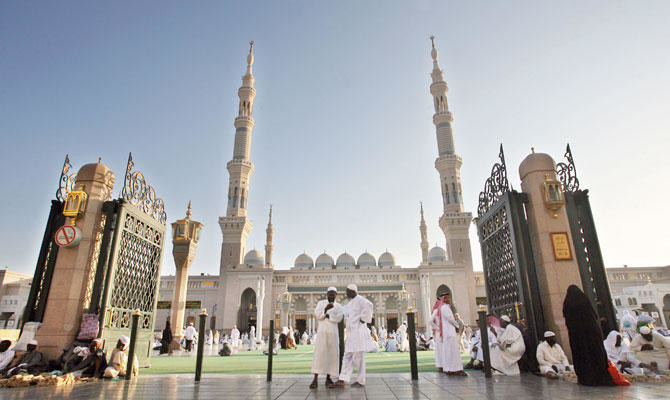
- The Prophet’s Mosque underwent its first expansion in the days of Caliph Umar ibn Al-Khattab in 17 AH (638 AD)
- The largest expansion of all time in the Prophet’s Mosque took place during the reign of the late King Abdullah alongside his umbrella project
US Embassy marks 248th Independence Day with shared US-Saudi vision for space exploration
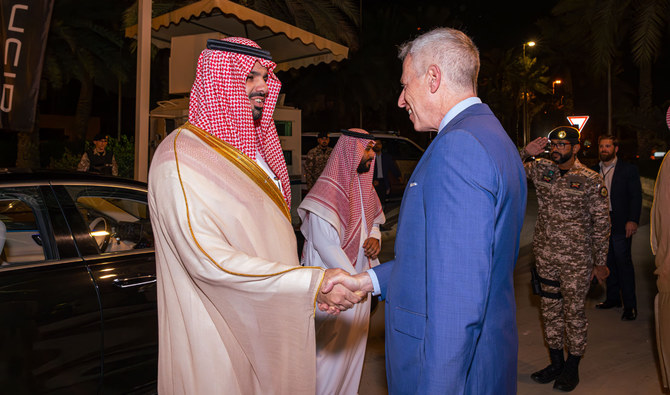
- Ambassador Michael Ratney welcomes hundreds of Saudi guests to space-themed Riyadh reception
RIYADH: The US Embassy in Riyadh celebrated the 248th anniversary of Independence Day on Thursday with a reception hosted by US Ambassador Michael Ratney.
The ambassador welcomed guest of honor Prince Faisal bin Abdulaziz bin Ayyaf, Riyadh Region mayor, along with Saudi officials, and hundreds of Saudi guests, as well as visitors from Washington, including members of the US Congress.
The space-themed Independence Day reception served as a symbolic celebration of the future of the US-Saudi cooperation in space, highlighting the profound benefits and possibilities of space exploration, research, and commercial development.
Ratney said the theme reflects the “shared ambition of the United States and Saudi Arabia to embrace opportunities in space, positioning both countries as pioneers in this frontier of innovation.”
The event evoked nostalgia for past achievements, such as the 1969 moon landing, while emphasizing ongoing advancements in space sciences, particularly commercial space exploration.
Ratney highlighted Saudi pioneers in space travel, such as Prince Sultan bin Salman, and astronauts Rayyanah Barnawi and Ali Al-Qarni.
An art installation, “Museum of the Moon,” by artist Luke Jerram, featured NASA’s high-definition imagery of the lunar surface.
According to the US Embassy’s statement, the collaboration between the US and Saudi Arabia continues to advance shared interests in diplomacy, commerce, culture, and more.
The US remains dedicated to enhancing shared US-Saudi shared interests in security and in fostering prosperity in the region, while also exploring new avenues for partnerships in areas such as the arts, education, entertainment, and tourism, it said.
Both countries are poised to explore further cooperation, including potential joint ventures in space, reflecting a vision for an even stronger US-Saudi relationship in the future, the statement added.
Saudi, Cypriot foreign ministers discuss relations
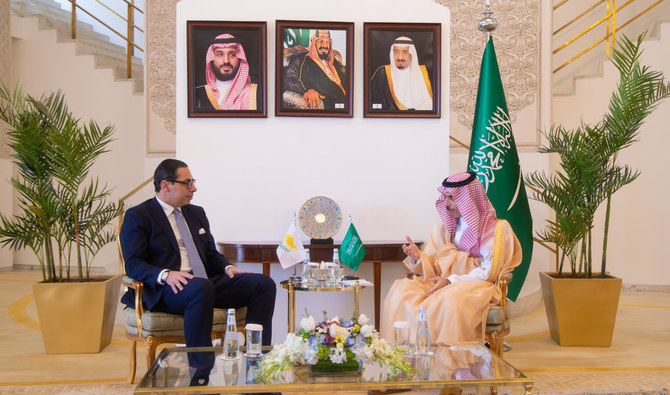
Saudi Minister of Foreign Affairs, Prince Faisal bin Farhan received his Cypriot counterpart, Dr. Konstantinos Kompos, at the ministry’s headquarters in Riyadh on Thursday.
During the meeting, the ministers reviewed the advanced bilateral relations between the Kingdom and the Republic of Cyprus, and ways to promote them in a variety of fields.
They also discussed ways to increase bilateral coordination on issues of common interest and reviewed international developments.
New initiative to train young innovators in nanotechnology
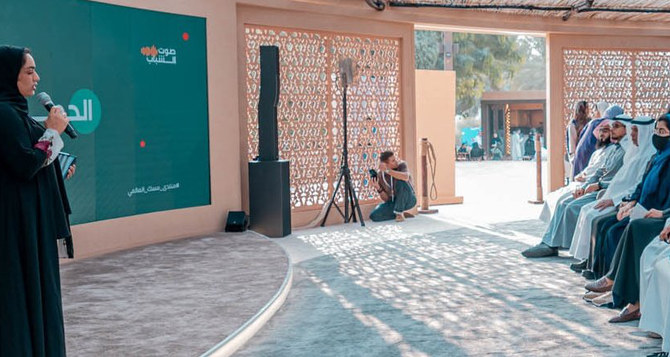
- Program structured in 3 phases for Saudi graduates and entrepreneurs
RIYADH: The Nanotechnology Association, supported by the Misk Foundation, is set to launch the Nanohub Program, aimed at inspiring and equipping the next generation for careers in the sector to help support a brighter future and a thriving economy.
Nanohub, a nonprofit initiative, is structured in three phases to train Saudi graduates and entrepreneurs aged between 20 and 26. It provides workshops and sessions to develop personal skills, gain hands-on experience with nanotechnology, and receive guidance from industry experts.
The program partners with leading local and international organizations to ensure participants are prepared for the workforce.
Nanotechnology is expected to transform business and innovation in various sectors. Understanding its economic impact and the potential benefits of partnerships are of crucial importance for young entrepreneurs.
The program aims to equip participants with the skills and knowledge needed to excel in nanotechnology and inspire them to drive innovation in their industries.
The first phase of the program will focus on soft skills and leadership development. It is scheduled for three days, starting on April 28.
The second phase, which starts on May 5, explores applications of nanotechnology. It runs for five days, covering topics like the fundamentals of nanotechnology, its use in medicine, energy, and renewable energy, as well as sustainability.
The third phase, beginning on May 12 and ending on May 16, provides hands-on laboratory experience through a series of sessions called “Shadowing and Lab Tours.” This phase has two key tracks: the Shadowing Track and the Lab Tours Track.
The Lab Tours Track will give participants an in-depth look at cutting-edge nanotechnology research. They will visit world-class laboratories where nanotechnology innovations are being developed.
Participants will observe advanced equipment and complex techniques central to nanotechnology research. They will see live experiments and dynamic processes that reveal the workings of nanotechnology. This track is more than just a tour as it enhances understanding by connecting academic concepts to real-world applications, giving participants a closer look at the research and development process.
The Nanohub Program is “a transformative initiative designed to elevate the skills and competencies of graduates and new hires with STEM (science, technology, engineering and mathematics) backgrounds,” said Dr. Turki Almugaiteeb, chairman of the board of the Nanotechnology Association.
“This unique initiative aims to enrich participants’ soft skills and technical expertise through curated activities.”
Almugaiteeb added that participants would “have the opportunity to delve into the intriguing realms of medicine and energy, witnessing firsthand how nanotechnology is revolutionizing these industries.”
He added: “By immersing themselves in this dynamic program, individuals will not only broaden their knowledge but also cultivate the multidisciplinary skills needed to thrive in today’s competitive and rapidly evolving STEM landscape.”
An enduring bond: A Jordanian photographer has turned his focus on two of the Arab world’s most beloved creatures

- Tariq Dajani’s first photographic exhibition of the horse and falcon series is on display at Ahlam Gallery in Al-Olaya, Riyadh
- Arabian horses have been the subject of songs and poetry praising their individual and physical qualities down through the ages
RIYADH: The Arabian horse and hunting falcon are important historical and cultural symbols for the Arab world, both ancient and modern.
Now a Riyadh gallery is highlighting this enduring bond with a series of portrait studies of both creatures by Tariq Dajani, a Jordanian photographer and printmaker.
Arabian horses have been the subject of songs and poetry praising their individual and physical qualities down through the ages.
However, Dajani, an owner of Arabians, chose to reflect his love of these creatures through photography and artworks.

Over the years he spent many sessions photographing horses in his native Jordan, as well as the UAE and Saudi Arabia. Later, toward the end of the project, he added the hunting falcon, another symbol of cultural heritage and pride among Arabs.
Dajani’s first photographic exhibition of the horse and falcon series is on display at Ahlam Gallery in Al-Olaya, Riyadh.
Entitled “Drinkers of the Wind,” the exhibition is the result of 16 years’ work creating portraits of these magnificent creatures.

Dajani told Arab News that he is delighted to be able to display his work in Saudi Arabia, “a country that is deeply connected to the horse and the falcon.”
Ahlam Gallery is the perfect place to showcase these artworks, he added.
Dajani’s treatment of his subjects is not in the usual natural or romantic manner. Instead, and this is partly what sets his art apart, he uses a studio portrait approach, where he takes his studio to the stables or falcon sheds, and spends time carefully working on portrait studies of the creatures.
“My aim is to find a connection of sorts with the horse or the birds,” he said. “I am not interested in documenting the creature; I try to go deeper, to express something emotionally if I can.
“I was living in Sweden when I decided to photograph the Arabian horse. So I had to return to the Middle East, and I started with Jordan, my home country.
“The way I approach the work is to present the horse on a backdrop where all my focus — and thus the viewers of the final picture — will be on the animal itself and not on the environment that it is in.”

While photographing in Jordan, Dajani met Princess Alia Al-Hussein, eldest daughter of the late King Hussein of Jordan. He presented some of his work to her, and received her enthusiastic approval.
Princess Alia gave him permission to photograph the horses of the Royal Jordanian Stud, and has continued to support his work over the years, opening his first two exhibitions in Jordan.
“I had access to some of the most beautiful horses in Jordan when I first started my project. My first exhibition solely of Jordanian Arabians was a great success,” Dajani said.
“Encouraged by the reception, and by now totally absorbed in this project, I went to Dubai, then Abu Dhabi, then Saudi Arabia, where I was presented with some of the most magnificent Arabian horses to photograph. Along the way, I introduced portrait studies of the hunting falcon. They, too, are strikingly beautiful and have a special place in Arab culture and heritage.
“I will always remain very grateful to Princess Alia for her initial support, and to many others for encouraging the work and opening doors for me along the way.”

One of his most striking photographs shows two mares bringing their heads together in a gentle greeting.
“This incredible and totally unanticipated greeting happened while I was photographing at the King Abdulaziz Arabian Horse Center in Dirab, south of Riyadh. The two mares were led out onto my backdrop studio space from opposite sides, and when they approached each other, they gently and courteously touched their heads as if to say hello,” he said.
“It was so special. No one had ever witnessed this before. We all held our breath as we watched in amazement. I frequently think that it would be nice if these sensitive, clever creatures could teach us humans a little bit of gentleness and respect.”
Dajani’s exhibition features high-quality photographic color prints, and a smaller collection of photogravure prints, produced by manually pulling an inked metal plate, engraved with the photographic image, through a traditional printing press — a slow and difficult process that produces prints with a special feel and texture.
Focus on emerging filmmakers at 11th Showreel Effat International Student Film Festival
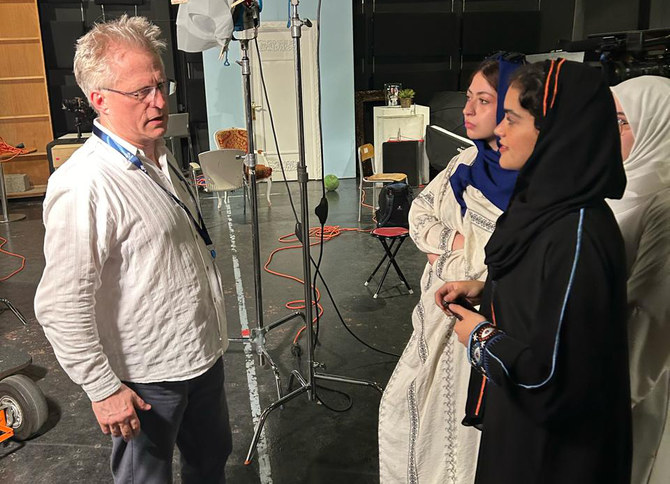
- The event included films by young Saudis and their peers from around the world, plus seminars and workshops presented by industry insiders
JEDDAH: Effat University’s School of Cinematic Arts in Jeddah welcomed aspiring filmmakers and cinephiles to the 11th Showreel Effat International Student Film Festival this week.
The theme for the three-day event, which concluded on Thursday, was “Behind the Seen,” reflecting the aim of organizers to shed light on the creative process and less-visible aspects of filmmaking. The program included a diverse range of cinematic offerings celebrating the work and talent of student filmmakers, not only those studying at the school but also their peers around the globe.
Mohammed Ghazala, head of the School of Cinema Arts, set the scene with an overview of the works featured during the festival, at the heart of which were films created by students and graduates of the school, which has been a pioneer in film and animation education in the Kingdom.
Alongside the home-grown talent, the festival provided a showcase for an impressive selection of international student films. These were carefully curated from a pool of 2,150 submissions from more than 115 countries, which were whittled down to a final selection of 57 exceptional works from 27 nations: Saudi Arabia, Egypt, Lebanon, Tunisia, Yemen, Morocco, Turkey, France, Belgium, Japan, Italy, Estonia, the Czech Republic, the US, China, New Zealand, Singapore, Canada, Taiwan, Russia, Greece, Spain, Poland, India, Indonesia, Mexico and Pakistan.
The chosen films competed for awards in seven categories, including Best Saudi Feature Film, Best International Animated Film, and the prestigious Audience Award.
In addition to providing a platform for emerging filmmakers to showcase their talent and creativity, organizers said the festival also aims to foster cultural exchanges and celebrate the art of cinema on a global scale.
Integral to this is a commitment to nurturing talent and encouraging dialogue within the industry, which was reflected in a series of seminars and workshops led by industry professionals. Effat University lecturer and festival coordinator Marina Ivanseva gave an overview of the sessions, which offered insights into a wide spectrum of topics key to the craft.
They included sessions on a creative cinematic post-production workshop supported by video-streaming service Netflix, cinematography workshops conducted by film camera manufacturer ARRI, and a visual effects workshop backed by specialist studio VFX Mojo.
They were presented by renowned figures and industry insiders such as Saudi artist Sarah Taibah, Oscar-winning German director Thomas Stelmach, British professor Rut Luxemburg, American visual effects artist Matt Beck, and cinematographer James Niehaus.
There were also lectures on animation and experimental film presented by the Royal College of Arts in London, while Stellmach offered insights into his professional journey that led to the Oscars. Saudi producer Nadia Malaika shared valuable career insights, Egyptian lawyer Khaled Al-Arabi discussed legal rights in filmmaking, and Mohammed Sobeih looked at the creation of animated films using Toon Boom software. The festival concluded with a session focusing on animated cinema presented by Synergy University.
“We were thrilled to welcome numerous local and international guests who shared their cinematic experiences with us … during the 11th Showreel Effat International Student Film Festival,” said Asmaa Ibrahim, the dean of Effat College of Architecture and Design.
“Students from Dar Alhekma, King Abdulaziz, and Princess Noura (universities) in Riyadh joined us in celebration. It was a delight to host guests from prestigious institutions such as the Royal College of Art, Netflix, Maflam, Film Association and VFX Mojo, who conducted exceptional workshops. The interactive discussions were engaging and we appreciate the participation of everyone.”
Karim Sahai, a visual effects professional from France, said: “I’m proud to have been a part of this incredible festival, with such a fantastic audience and remarkable guests from all over.
“The quality of their engagement and the depth of their questions during my workshop surpassed my expectations. I truly believe I’ll return to bask in this energy once more; it’s truly inspiring.”
Beyond artistic appreciation, organizers said another aim of the festival is to help forge academic and strategic partnerships, and Effat University has built alliances with institutions such as the University of Southern California and the Red Sea Film Festival Foundation with the goal of fostering collaboration and exchange of knowledge on a global scale.





